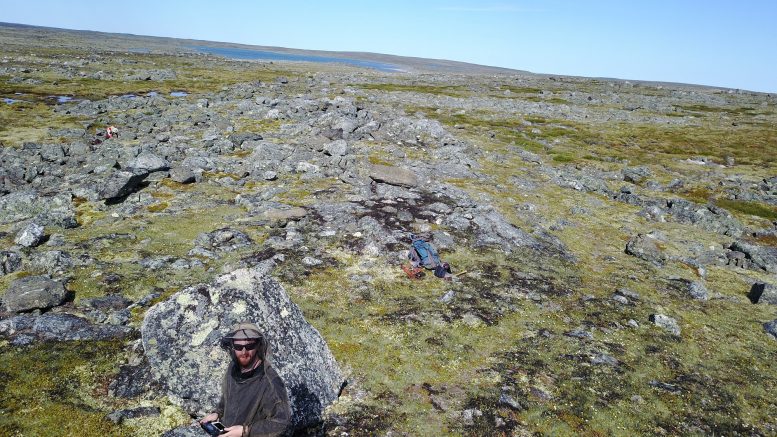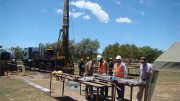The latest news from active diamond explorers, developers and miners in Canada.
Altius Minerals
Altius Minerals (TSX: ALS) is planning to spin off its Lynx project, located near Oxford House in Manitoba, into a new public company. As part of those plans, Altius is planning to release a technical report on the project, which it acquired in early 2017, in the second quarter.
Fifteen samples taken from the project’s Eastern Bay zone last year returned 1,693 microdiamonds from 240 kg of ultramafic host units collected over a 3-km strike length.
Eight of the stones were macrodiamonds (at least 0.5 mm). The diamonds show positive characteristics: 24% of the stones larger than 0.3 mm were white/colourless, 45% off-white and 17% octahedral.
De Beers
De Beers announced last November that production at its Victor mine, in Ontario, will end in the first quarter of 2019.
While it had previously been advancing its Tango extension at Victor, spokesman Tom Ormsby said the project is not economic once Victor has been mined out.
“The potential of any other kimberlites on the property are not foreseeably economic with the current infrastructure and footprint, so Victor will enter the closure phase once operations cease.”
Ormsby added that the mine set a production record in 2017 and has the potential to set another production record in its last year of operation. Victor had originally been forecast to produce 6 million carats of diamonds over its mine life, but has already produced 7 million carats.
There had been tensions with the local Attawapiskat First Nation regarding De Beers’ plans to explore Tango, but Ormsby told Northern Ontario Business in November that the decision was purely based on economics.
The company has budgeted $7.4 million this year for progressive reclamation, which has been ongoing for several years. Victor is Ontario’s only diamond mine.
Dominion Diamond Mines
Now privately owned by Washington Companies, Dominion Diamond Mines is reportedly delaying further work at its Jay development at its Ekati mine in the Northwest Territories. CBC News reported in May that the company was examining ways to increase the project’s profitability. Construction at Jay had been slated to begin in 2018. A 2016 feasibility study had pegged the project’s cost at US$647 million, its post-tax internal rate of return (IRR) at 15.6% and its (net present value) NPV at US$398 million. The study used a 2015 base case value of US$53 per carat for Jay diamonds.
Dunnedin Ventures
In April, Dunnedin Ventures (TSXV: DVI) began its first drill campaign at its Kahuna project in Nunavut. The junior has been advancing the project for three years through till sampling and geophysical exploration programs, building on work completed by previous operators. It also released a first resource for the Kahuna and Notch dykes based on previous drilling and sampling in 2015. The two kimberlites host 4 million carats of diamonds contained in 4 million tonnes grading 1.01 carats per tonne.
The company had planned to drill 17 kimberlite targets during the spring program, but weather delays meant it only had time to test five targets with rotary air blast drill holes.
Kimberlite has so far been intercepted at two of the targets — both extensions of existing, diamond-bearing kimberlite dykes. Drilling has extended the known diamond-bearing PST kimberlite to 350 metres in strike length and the 07KD-24 kimberlite to 225 metres in strike length.
Drilling will continue in June, including at high-priority targets thought to be kimberlite pipes. In November, the company brought Claudia Tornquist on as president. Tornquist spent nine years with Rio Tinto in multiple roles, including working on the underground expansion of the Argyle diamond mine in Australia, and at Diavik in the Northwest Territories.
GGL Resources
In April, GGL Resources (TSXV: GGL) announced the acquisition of three new land packages in the Lac de Gras area of the Northwest Territories: Bishop, Zeus and Rhombus. All three were acquired by staking and are strategically located based on historic discoveries of diamond-bearing kimberlites, previous positive exploration results, and the company’s proprietary database.
Margaret Lake Diamonds
In May, Margaret Lake Diamonds (TSXV: DIA) began a core drilling campaign to test six kimberlite targets at its Margaret Lake property, just 9 km north of Gahcho Kué in the Northwest Territories. Each of the targets displays a gravity low, bedrock conductor or combination of both, as well as geophysical characteristics associated with kimberlite bodies. The company is using methods similar to those that Kennady Diamonds used successfully to delineate kimberlite targets at its nearby Kennady North project.
Margaret Lake also holds 60% of the Diagras property in Lac de Gras with Arctic Star Exploration.
Mountain Province Diamonds
Mountain Province Diamonds (TSX: MPVD; NASDAQ: MPVD) closed the acquisition of Kennady Diamonds in April. The company announced the all-share merger with the junior, which was originally spun out of Mountain Province in 2012 to advance the Kennady North project adjacent to Gahcho Kué, in January.
The company also appointed former De Beers executive Stuart Brown as CEO in May, following the departure of Patrick Evans to join Dominion Diamond Mines last summer.
Gahcho Kué, a 49/51% joint venture between Mountain Province and De Beers, began commercial production in March 2017. In the first quarter of 2018, Mountain Province reported net earnings of $67,000 on revenues of $67 million. The company sold 527,000 carats at an average price of $126 per carat for the quarter. (In 2017, Mountain Province reported total diamond sales worth $238 million with an average achieved price of $89 per carat.)
The mine is expected to produce a total of 6.3-6.6 million carats in 2018.
North Arrow Minerals
North Arrow Minerals (TSXV: NAR) discovered a new kimberlite field at Mel in Nunavut late last year — its second such find after the diamondiferous Pikoo project in Saskatchewan. Mel will see its first-ever drill program, testing several kimberlite targets, in July. A 62.1-kg sample taken from the ML-8 kimberlite, discovered by prospecting last year, returned 23 diamonds larger than 0.106 mm, including one macrodiamond (over 0.85 mm).
Mel is located 210 km northeast of Naujaat — North Arrow’s most advanced project. The company is making preparations for a 5,000-10,000 tonne bulk sample at the Q1-4 kimberlite at Naujaat to collect enough diamonds for an accurate valuation and to inform a PEA. Q1-4 contains an inferred resource of 26.1 million carats in 48.8 million tonnes grading 53.6 carats per hundred tonnes (cpht) to a depth of 205 metres.
To facilitate a bulk sample at Q1-4, North Arrow is looking at options to build a road. The project is 9 km northeast of the community of Naujaat (Repulse Bay), and only 7 km from tidewater.
In April, North Arrow reported the discovery of a new kimberlite at Target 465 at its Loki project, adjacent to its 45%-owned LDG joint-venture project with Dominion Diamond Mines. The discovery is the first in the Lac de Gras kimberlite field in the past five years.
Olivut Resources
In December, Olivut Resources (TSXV: OLV) closed a $300,000 flow-through financing for exploration at its HOAM project in the Northwest Territories.
Peregrine Diamonds
In May, Peregrine Diamonds (TSX: PGD) released an updated preliminary economic assessment for its Chidliak project, in Nunavut, that incorporates expanded resources at the CH-6 and CH-7 kimberlites.
The study increases total carats recovered at Chidliak by 44%, its mine life by 30% and the project’s after-tax NPV by 44% compared to a 2016 PEA.
For an initial capital cost of $455 million, Chidliak is projected to produce 16.7 million carats over a mine life of 13 years. The project’s after-tax NPV is estimated at $679 million, with an after-tax IRR of 31.1%.
CH-6 contains an inferred resource of 17.96 million carats in 7.5 million tonnes grading 2.41 carats per tonne to a depth of 525 metres. CH-7 contains 4.23 million carats in 5 million tonnes grading 0.85 carat per tonne. CH-6 diamonds are valued at US$151 per carat and CH-7 diamonds at US$114 per carat.
There is potential to expand resources at both CH-6 and CH-7. The study looks at open-pit mining of CH-6 to a depth of 300 metres.
Last November, Peregrine reported finding a rare green diamond in a sample at CH-6.
Rio Tinto
Rio Tinto (NYSE: RIO) reported in February that development of the A21 pipe at its 60% owned Diavik mine, in the Northwest Territories, remains on schedule and within budget. Dyke construction and dewatering were complete early this year and first production from A21 is expected in mid-2018. The pipe is the fourth to be developed and is expected to support mining until 2025. Rio Tinto’s 40% partner at the mine is Dominion Diamond.
Rio Tinto is also completing work at Star Diamond’s Star-Orion South project in Saskatchewan.
Stornoway Diamond
Stornoway Diamond’s (TSX: SWY) Renard mine in Quebec achieved commercial production at the start of 2017, but experienced high levels of breakage that negatively affected the sales price of its production. As a result, it introduced an ore-waste sorting circuit, which was commissioned at the end of the first quarter of 2018.
The company reported a net loss of $11 million for its first quarter of 2018, as it transitions from open-pit mining to underground mining and relies on lower grade material from stockpiles and initial stope development. The company reduced its guidance for the year to 1.35-1.4 million carats from 1.6 million carats. During the first quarter, Stornoway sold 399,135 million carats for a total of $56.6 million at an average price of US$112 per carat.
By the end of the second quarter, the company expected its transition to underground mining to be complete, with the ore-sorting circuit expected to improve diamond recoveries and quality.
—This article originally appeared in the June 2018 issue of Diamonds in Canada magazine.




Be the first to comment on "All that glitters in the True North: The latest from diamond miners in Canada"